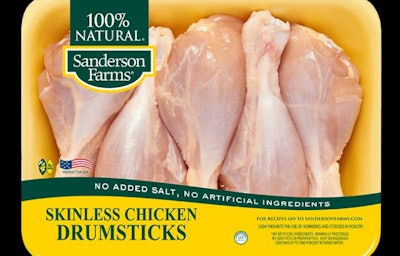
Sanderson Farms has not held a quarterly earnings call since this time last year, when the chicken company announced its financial results of the second quarter of fiscal year 2021.
Not long after that, in August 2021, the proposed deal that would merge Sanderson Farms with Wayne Farms was announced, and those calls stopped.
The publicly traded Sanderson Farms still discloses information for its financial performance each quarter, but the color and commentary provided by Sanderson executives Joe F. Sanderson Jr., Lampkin Butts and Mike Cockrell during those calls have been sorely missed.
For the most recent quarter, which ended April 30, I referred to the Form 10-Q on the Sanderson Farms Investor Relations webpage. I’ll cover four key topics addressed by the company on that form below.
1. Status of the merger
Obviously, the main topic on people’s minds is if or when the proposed merger with Wayne Farms will be finalized.
It was announced on August 9, 2021, that a deal had been reached in which Cargill and Continental Grain Company, the owner of Wayne Farms, would acquire Sanderson Farms and merge it with Wayne Farms.
But that proposed transaction has been under heavy scrutiny, and what was once believed to be a deal that would be finalized in late 2021 or early 2022 is a deal that still hasn’t happened.
In the Form 10-Q, Sanderson Farms disclosed that the involved companies on December 20, 2021, received a request for additional information and documentary material from the U.S. Department of Justice (DOJ) in connection with the DOJ's review of the transaction contemplated by the merger agreement. The companies have complied with that request, and will continue to cooperate with the DOJ, Sanderson Farms said, it its review. And while only one month remains in the first half of the calendar year 2022, Sanderson Farms stated that the involved parties expect that the merger will be completed before the second half of the calendar year.
2. Second quarter results
Sanderson Farms had a strong quarter, more than tripling its net income when compared to the same period of the 2021 fiscal year. Net income went from $96.9 million to $321.2 million on a year-over-year basis.
The net sales also increased, going from $1.13 billion to $1.54 billion, with sales of all categories increasing.
3. Avian influenza
Sanderson Farms has fared pretty well during the 2022 highly pathogenic avian influenza outbreak. The virus has been confirmed in only one Sanderson Farms flock in North Carolina.
“We have a high degree of confidence in our industry’s biosecurity program, but we cannot be certain our flocks or others in our industry will not be significantly affected by AI. Given our high degree of confidence in our biosecurity programs, we believe the primary risks associated with domestic outbreaks of AI are market risks, as many countries to which our industry sells product typically impose bans on the import of broiler meat produced in the United States when AI is found. The extent of the bans varies by country and can range from county-specific, which means product of a certain county is banned, to nationwide, under which any poultry produced in the United States is banned,” the company stated.
“If AI were to affect a significant number of our flocks, or materially reduce domestic demand for our products, either or both of these events could have a material adverse effect on our business, reputation or prospects.”
4. War in Ukraine
Sanderson Farms stated that the primary risk it faces through the conflict between Russia and Ukraine has to do with uncertainty surrounding the region’s corn and fertilizer production.
“The impact that uncertainty has had and could continue to have on the price of corn, which is the largest component of our total feed costs,” the company stated.
While we do not import corn or other feed grains directly from the region, Ukraine’s inability to plant, grow and harvest a material portion of its grain crops will negatively impact the worldwide supply of grain, including corn, and will continue to put upward pressure on grain prices. Due to the ongoing conflict, shipping channels through which old-crop grain would normally be exported are blocked or disrupted, and only a fraction of normal exports are able to be transported. These uncertainties, together with already tight global grain supplies, have caused grain prices to rise and exhibit significant volatility since the invasion began. That trend will likely continue.”

















